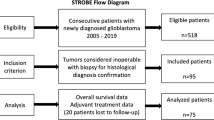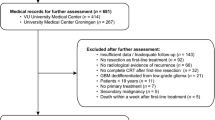Abstract
The role of surgical resection in progressive or recurrent glioblastoma multiforme (GBM) lack of high level of evidence. The aim of this evaluation was to assess the role of surgical resection in relapsing GBM, in relation to the extent of surgical resection (EOR) and the amount of residual tumor volume (RTV). Among patients treated for newly diagnosed GBM between September 2008–December 2014, 64 patients with recurrent GBM were included in this retrospective evaluation. All patients underwent surgical resection followed by adjuvant treatments, chemotherapy and/or radiotherapy Results were evaluated in terms of local control (LC) rate, progression free survival (PFS) and patients overall survival (OS). Gross total resection (GTR) (>90%) was achieved in 48 (75%) patients and subtotal resection (STR) in 16 (25%). RTV was 0 in 40 (62.5%) patients and >0 in 24 (37.5%). No severe postoperative morbidity occurred. The median LC time was 6.0 ± 0.1 months (95% CI 5.29–8.55), with a 1 and 2 years LC rate of 29.4 ± 6.9%. The median PFS time was 6.8 ± 0.8 months, with a 1 year PFS rate of 27.2 ± 7.2% (95% CI 14.2–41.9). The median OS time was 10.3 ± 0.5 months (95% CI 7.6–10.4) with a 1 and 2 years OS rate of 22.5 ± 6.7% (95% CI 10.9–36.6). On univariate analysis EOR and RTV were recorded as conditioning LC and survival. These data was confirmed also in multivariate analysis only for RTV (p < 0.01). Recurrent GBM can take advantage of repeated surgery in selected patients with younger age and good clinical status. The entity of surgical resection was confirmed as conditioning survival.



Similar content being viewed by others
References
Stupp R, Hegi M, Mason W et al (2009) Effects of radiotherapy with concomitant and adjuvant temozolomide versus radiotherapy alone on survival in glioblastoma in a randomised phase III study: 5-year analysis of the EOTC-NCIC trial. Lancet Oncol 10:459–466
Johnson D, O’Neill B (2012) Glioblastoma survival in the United States before and during the temozolomide era. J Neurooncol 107:359–364
National Comprehensive Cancer Network NCCN guidelines (2012) Central nervous system cancers. http://www.nccn.org/professionals/physiciangls/fguidelines.asp
Minniti G, Amelio D, Amichetti M et al (2010) Patterns of failure and comparison of different target volume delineations in patients with glioblastoma treated with conformal radiotherapy plus concomitant and adjuvant temozolomide. Radiother Oncol 97:377–381
Barbagallo G, Jenkinson M, Brodbelt A (2008) “Recurrent” glioblastoma multiforme, when should we reoperate? Br J Neurosurg 22:452–455
Park J, Hodges T, Arko L et al (2010) Scale to predict survival after surgery for recurrent glioblastoma multiforme. J Clin Oncol 28:3838–3843
Wick W, Platten M, Weller M (2009) New (alternative) temozolomide regimens for the treatment of gliomas. Neuro Oncol 11:69–79
Wick W, Weller M, Weiler M, Matchelor T, Yung A, Platten M (2011) Pathway inhibition: emerging molecular targets for treating glioblastoma. Neuro Oncol 13:566–579
Combs S, Widmer V, Thilmann C, Hof H, Debus J, Schulz-Ertner D (2005) Stereotactic radiosurgery (SRS): treatment option for recurrent glioblastoma multiforme (GBM). Cancer 104:2168–2173
Fuller C, Choi M, Forthuber B et al (2007) Standard fractionation intensity modulated radiation therapy (IMRT) of primary, recurrent glioblastoma multiforme. Radiat Oncol 2:26
Navarria P, Ascolese A, Tomatis S et al. (2016) Hypofractionated stereotactic radiation therapy in recurrent high-grade glioma: a new challenge. Cancer Res Treat 48:37–44
Ammirati M, Galicich J, Arbit E, Liao Y (1987) Reoperation in the treatment of recurrent intracranial malignant gliomas. Neurosurgery 21:607–614
Barker F, Chang S, Gutin P et al (1998) Survival and functional status after resection of recurrent glioblastoma multiforme. Neurosurgery 42:709–720
Chaichana K, Zadnik P, Weingart J et al (2013) Multiple resections for patients with glioblastoma: prolonging survival. J Neurosurg 118:812–820
Dirks P, Bernstein M, Muller P, Tucker W (1993) The value of reoperation for recurrent glioblastoma. Can J Surg 36:271–275
Helseth R, Helseth E, Johannesen T et al (2010) Overall survival, prognostic factors, and repeated surgery in a consecutive series of 516 patients with glioblastoma multiforme. Acta Neurol Scand 122:159–167
Berger M, Tucker A, Spence A, Winn H (1992) Reoperation for glioma. Clin Neurosurg 39:172–186
Daneyemez M, Gezen F, Canakci Z, Kahraman S (1998) Radical surgery and reoperation in supratentorial malignant glial tumors. Minim Invasive Neurosurg 41:209–213
Park C, Kim J, Nam D et al (2013) A practical scoring system to determine whether to proceed with surgical resection in recurrent glioblastoma. Neuro Oncol 15:1096–1101
Bloch O, Han S, Cha S et al (2012) Impact of extent of resection for recurrent glioblastoma on overall survival. J Neurosurg 117:1032–1038
Oppenlander M, Wolf A, Snyder L et al (2014) An extent of resection threshold for recurrent glioblastoma and its risk for neurological morbidity. J Neurosurg 120:846–853
Patel A, Suki D, Hatiboglu M, Rao V, Fox B, Sawaya R (2015) Impact of surgical methodology on the complication rate and functional outcome of patients with a single brain metastasis. J Neurosurg 122:1132–1143
Mandl E, Dirven C, Buis D, Postma T, Vandertop W (2008) Repeated surgery for glioblastoma multiforme: only in combination with other salvage therapy. Surg Neurol 69:506–509
Sanai N, Polley M, McDermott M, Parsa A, Berger M (2011) An extent of resection threshold for newly diagnosed glioblastomas. J Neurosurg 115:3–8
McGirt M, Chaichana K, Gathinji M et al (2009) Independent association of extent of resection with survival in patients with malignant brain astrocytoma. Clinical article. J Neurosurg 110:156–162
Pessina F, Navarria P, Cozzi L et al (2016) Value of surgical resection in patients with newly diagnosed grade III glioma treated in a multimodal approach: surgery, chemotherapy and radiotherapy. Ann Surg Oncol 23:3040–3046
Lim DA, Cha S, Mayo MC et al (2007) Relationship of glioblastoma multiforme to neural stem cell regions predicts invasive and multifocal tumor phenotype. Neuro Oncol 9:424–429
Lamborn KR, Chang SM, Prados MD. (2004) Prognostic factors for survival of patients with glioblastoma: recursive partitioning analysis. Neuro Oncol 6:227–235
Author information
Authors and Affiliations
Corresponding author
Ethics declarations
Conflict of interest
L. Cozzi acts as Scientific Advisor to Varian Medical Systems and is Clinical Research Scientist at Humanitas Cancer Center. All other co-authors have no conflicts of interest.
Rights and permissions
About this article
Cite this article
Pessina, F., Navarria, P., Cozzi, L. et al. Role of surgical resection in recurrent glioblastoma: prognostic factors and outcome evaluation in an observational study. J Neurooncol 131, 377–384 (2017). https://doi.org/10.1007/s11060-016-2310-y
Received:
Accepted:
Published:
Issue Date:
DOI: https://doi.org/10.1007/s11060-016-2310-y




